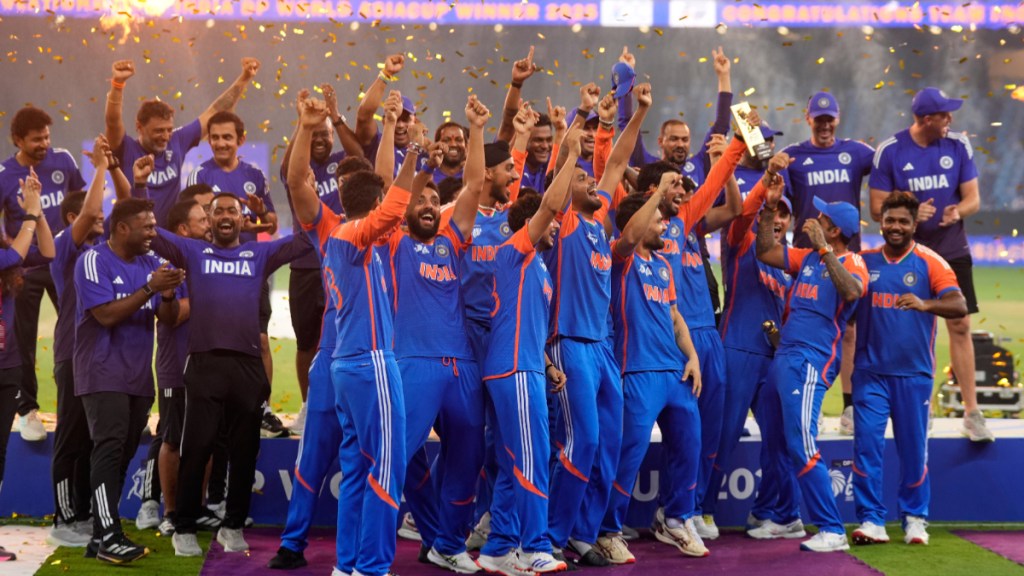In Dubai, cricket should have been allowed to tell its own story: ball against bat, nerves clashing with nerves, and the collective pulse of millions running through every delivery. Instead, the game became smothered by a script written outside the boundary rope.
The Match That Couldn’t Breathe on Its Own
The Asia Cup final had all the elements of a sporting classic. Tilak Varma’s nerve of steel, Shivam Dube’s finishing touch, Pakistan’s dramatic collapse, and India’s ninth title. Yet these heroics were overshadowed by everything else; the hour-long delay at the presentation, the refusal to accept the trophy from Mohsin Naqvi, and the bizarre sight of champions lifting an imaginary cup. Naqvi insisted on handing over the trophy himself, despite knowing how India would respond; especially when in 2022 Jay Shah, then ACC chairman, skipped the final altogether and allowed a Sri Lankan board official to present it without fuss. The standoff ended with Pakistan captain Salman Ali Agha flinging the runner-up cheque in frustration, a gesture that summed up the bitterness of the night. The cricket was alive, but its heartbeat was drowned out by politics.
From Kargil to Dubai: What Changed
It was not always this way. India and Pakistan have played in far more tense times, during the Kargil War in 1999 at the World Cup and in Australia’s tri-series soon after, when cricket somehow managed to stand apart from the noise. Back then there were protests, but the game still stood taller than politics. Players shook hands, crowds turned up, and administrators stayed behind the curtains.
What has shifted since then is how every gesture and every silence is loaded with political meaning. A pointed airplane sign by Haris Rauf, mirrored later by Jasprit Bumrah, becomes a symbolic extension of national pride or national insult. The same act condemned when done by one side was celebrated when mirrored by the other. The contradiction is not unique; it is stitched into both sets of fans, political circles, and media echo chambers.
Social Media Frontline
Platforms that should simply amplify the sport have turned into echo chambers where every moment is weaponised. A refused handshake or a symbolic gesture now snowballs into nationalist theatre.
Administrators have not helped. Naqvi himself fanned flames with fighter-jet imagery before the final. It was less the conduct of an impartial cricket body president and more the rhetoric of a propagandist. In that environment, players no longer act purely as cricketers but as unwilling actors in a drama directed by political parties, cricket boards, and the mob of online voices.
Political Hypocrisy in Plain Sight
Perhaps the most dissonant moment was hearing politicians in India explain before the tournament that sport, art, and culture should stay away from politics, only to claim victory over Pakistan as a symbolic Operation Sindoor once the cup was won. This shifting justification is not just opportunism; it is an admission that cricket is being used as a political currency, cashed in whenever it suits the mood of the nation. Across the border, Pakistani politicians do the same dance. Wins are painted as proof of resilience, defeats as evidence of betrayal or conspiracy. The pattern is predictable, and yet it never fails to stir emotions on both sides. What might have been a bilateral sporting rivalry is now theatre for nationalistic posturing.
What should have been cherished as one of sport’s greatest rivalries has been stripped of its innocence. Instead of being about cricketing skill and shared respect, it has been turned into a stage where national pride is performed and political points are scored. Each result is twisted to suit the moment, showing clearly that cricket is not being shielded from politics anymore; it is being used by it.
Sports No One Talks About
The double standards become obvious the moment you step outside cricket. In June 2025, India and Pakistan contested the Asian Squash Doubles Championship final. In September their under-17 football teams clashed in the SAFF Championship. These events came and went without sparking outrage. No political party issued statements. No one demanded a boycott. No memes, no insults, no calls for bans. The reason is obvious: squash and football in South Asia do not provide the same political mileage. Cricket, on the other hand, has become too valuable a stage for symbolic warfare.
This selective outrage reveals the uncomfortable truth. The rivalry is less about principle and more about visibility. Politicians, administrators, and even sections of the public exploit cricket because it offers instant gratification. A six in Dubai becomes a strike for national honor. A handshake refused becomes defiance against the enemy. The endless loop of outrage and chest-thumping does not serve the game at all; it only serves those in power.
The Hidden Cost
The part nobody wants to talk about is the quiet damage being done. For the players, it means carrying the weight of national pride when all they really want is to play cricket. For the fans, it takes away the joy of just watching a match unfold, because every run and every wicket feels burdened with politics And the spirit of cricket, which once allowed India and Pakistan to play even during the Kargil War, is left strangled by agendas that value point-scoring over respect.
Politics One, Cricket Zero
The Asia Cup final should have gone down in memory for Tilak Varma’s calm under pressure and India’s fightback from the brink. Instead, it will be remembered for delays, symbolic snubs, and an imaginary trophy. On the scorecard India beat Pakistan. But in the bigger picture, politics beat cricket.
Disclaimer: Opinions expressed are solely those of the author and not necessarily reflect the views of financialexpress.com.

